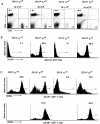The common cytokine receptor gamma chain plays an essential role in regulating lymphoid homeostasis
- PMID: 9016868
- PMCID: PMC2196113
- DOI: 10.1084/jem.185.2.189
The common cytokine receptor gamma chain plays an essential role in regulating lymphoid homeostasis
Abstract
In the immune system, there is a careful regulation not only of lymphoid development and proliferation, but also of the fate of activated and proliferating cells. Although the manner in which these diverse events are coordinated is incompletely understood, cytokines are known to play major roles. Whereas IL-7 is essential for lymphoid development, IL-2 and IL-4 are vital for lymphocyte proliferation. The receptors for each of these cytokines contain the common cytokine receptor gamma chain (gammac), and it was previously shown that gammac-deficient mice exhibit severely compromised development and responsiveness to IL-2, IL-4, and IL-7. Nevertheless, these mice exhibit an age-dependent accumulation of splenic CD4+ T cells, the majority of which have a phenotype typical of memory/activated cells. When gammac-deficient mice were mated to DO11.10 T cell receptor (TCR) transgenic mice, only the T cells bearing endogenous TCRs had this phenotype, suggesting that its acquisition was TCR dependent. Not only do the CD4+ T cells from gammac-deficient mice exhibit an activated phenotype and greatly enhanced incorporation of bromodeoxyuridine but, consistent with the lack of gammac-dependent survival signals, they also exhibit an augmented rate of apoptosis. However, because the CD4+ T cells accumulate, it is clear that the rate of proliferation exceeds the rate of cell death. Thus, surprisingly, although gammac-independent signals are sufficient to mediate expansion of CD4+ T cells in these mice, gammac-dependent signals are required to regulate the fate of activated CD4+ T cells, underscoring the importance of gammac-dependent signals in controlling lymphoid homeo-stasis.
Figures



References
-
- Noguchi M, Yi H, Rosenblatt HM, Filipovich AH, Adelstein S, Modi WS, McBride OW, Leonard WJ. Interleukin-2 receptor γ chain mutation results in X-linked severe combined immunodeficiency in human. Cell. 1993;73:147–157. - PubMed
-
- Leonard WJ, Noguchi M, Russell RM, McBride OW. The molecular basis of X-linked severe combined immunodeficiency: the role of the interleukin-2 receptor γ chain as a common γ chain, γc . Immunol Rev. 1994;138:61–86. - PubMed
-
- Sugamura K, Asao H, Kondo M, Tanaka N, Ishii N, Nakamura M, Takesha T. The common γ-chain for multiple cytokine receptors. Adv Immunol. 1995;59:225–277. - PubMed
-
- Leonard WJ. The molecular basis of X-linked severe combined immunodeficiency: defective cytokine receptor signaling. Annu Rev Med. 1996;47:229–239. - PubMed
-
- Leonard WJ, Shores EW, Love PE. Role of the common cytokine receptor γ chain in cytokine signaling and lymphoid development. Immunol Rev. 1995;148:97–114. - PubMed
Publication types
MeSH terms
Substances
LinkOut - more resources
Full Text Sources
Other Literature Sources
Molecular Biology Databases
Research Materials

